Become a Green Practice and See Your Business Bloom
The What, Why and How of Going Green
By Mark Mattison-Shupnick ABOM
Release Date: May 22, 2013
Expiration Date: December 31, 2017
Learning Objectives:
Upon completion of this program, the participant
should be able to:
- Understand the shift in consumer preference for sustainable products.
- Learn how the eyewear can be part of a sustainable practice.
- Understand the steps to becoming a green practice.
- Learn the component parts of being certified and communicating a sustainability program.
Faculty/Editorial Board:
 Mark Mattison-Shupnick ABOM is currently director of education for Jobson Medical Information LLC, has more than 40 years of experience as an optician, was senior staff member of SOLA International and is a frequent lecturer and trainer.
Mark Mattison-Shupnick ABOM is currently director of education for Jobson Medical Information LLC, has more than 40 years of experience as an optician, was senior staff member of SOLA International and is a frequent lecturer and trainer.
Support:
This course is supported by an educational grant from MODO.
Credit Statement:
This course is approved for one (1) hour of CE credit by the American Board of Opticianry (ABO). Course #SWJHI521
This course is supported by an educational grant from MODO and ECO Eyewear
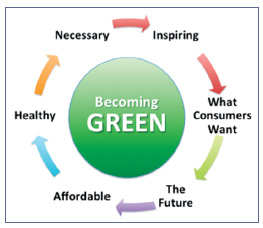 More than eight out of every
10 consumers buy green
products or select products
from companies that are
"green" in any variety of
ways. If so many people think
green is important, then hav-
ing a green conscience, using
green products and commu-
nicating that you participate in the greening
of the world makes a difference in the way
consumers view you and your business.
More than eight out of every
10 consumers buy green
products or select products
from companies that are
"green" in any variety of
ways. If so many people think
green is important, then hav-
ing a green conscience, using
green products and commu-
nicating that you participate in the greening
of the world makes a difference in the way
consumers view you and your business.
"Green has gone mainstream," writes Jacquelyn Ottman in her book The New Rules of Green Marketing (February 2011). "Today, 83 percent of consumers representing four generations— Baby Boomers, Millennials, Gen Ys and Gen Zs—are some shade of green. In fact, the green industry is now a $290 billion industry (Source: Natural Marketing Institute, 2009). " For perspective, the optical industry generates just under $35 billion. This suggests that adding and communicating green as a part of your practice addresses what consumers see as a requirement for any business.
Becoming green is aspirational. It's a set of goals that can be accomplished one step or multiple steps at a time. It doesn't require complex technology but a commitment individually and as a team when choosing products and organizing daily tasks. Becoming a green practice should be a part of every office's branding plan since green resonates with consumers. Here's how.
GREEN IS RIGHT
Why should you aspire to being greener personally and in your practice? The answer is simple: It's the right thing to do. In fact, 67 percent of consumers are looking for greener products; however, green still represents an unmet consumer demand. A GMA/Deloitte Green Shopper Study (2009) discovered that sustainability considerations either drive or influence the buying decisions of more than half of the shoppers interviewed in the study. Green consumers shop more often and spend more when they do.
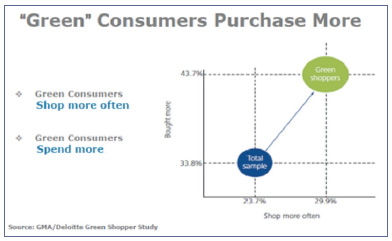 Erinn Morgan, author of the book Picture
Yourself Going Green (Cengage Learning, 2009)
defines becoming green as a cycle, i.e., green is
the future (what we create for future generations that they will inherit), is affordable (conservation can be budget-boosting), healthy
(personal choices affect self and others), necessary (responsible to the environment and
individuals) and inspiring (looked up to, by
self and others). When considering that green
also drives consumer opinion, it suggests adding "what consumers want" to the circle, since
that fits with the two-thirds of consumers
looking for greener products.
Erinn Morgan, author of the book Picture
Yourself Going Green (Cengage Learning, 2009)
defines becoming green as a cycle, i.e., green is
the future (what we create for future generations that they will inherit), is affordable (conservation can be budget-boosting), healthy
(personal choices affect self and others), necessary (responsible to the environment and
individuals) and inspiring (looked up to, by
self and others). When considering that green
also drives consumer opinion, it suggests adding "what consumers want" to the circle, since
that fits with the two-thirds of consumers
looking for greener products.
Additionally, being green fits with the changing demographics of business. In optical, the 77 million baby boomers that have driven much of premium eyewear sales will be eclipsed by 82 million millennials (those born between 1977 and 1997). Millennials have a strong interest in health centered on their own wellness and the environment around them. Here are some key facts from "A Look at Key Sustainability Trends in the U.S. 2012," conducted by NMI Solutions, a global strategy and market research firm. First, the percentage of Generation Y (1977 to 1997) who reports that they "buy as many green/eco-friendly products as they can" is up to 36 percent in 2012 from 31 percent in 2009, a 16 percent growth rate during some tough economic times. Second, Generation Y seems to have higher expectations of sustainability being "baked in" to the product, rather than a line or brand extension; the whole line should incorporate sustainable attributes. Third, Generation Y is sure to shape the marketplace around its needs and desires. And Generation Y consumers have decades of purchase decisions ahead of them.
According to a 2011 MIT survey, sustainability is now a part of 70 percent of corporate agendas. How do consumers know where to shop for green products? From the Green Business Bureau (GBB), 55 percent of today's consumers look for eco-labels on business and products. Almost three-quarters of today's consumers actively seek out trust seals and privacy marks before doing business with a merchant. More than 80 percent of Americans believe third-party certification plays an important role in the oversight of environmental messaging. By using eco-conscious labeling, your office can tap into a green economy that is growing 10 times faster than the general economy. In fact, by 2015, it is estimated that 60 percent of U.S. adults will identify themselves as green.
Becoming a green practice and advertising it attracts customers because green is important to current consumers. Green differentiates your office from others, improves an image of trust in the community and becomes a part of the reason for customer loyalty. Having a defined set of green goals and a green identity can motivate and inspire staff. Put it all together, and it can grow a business and do some good at the same time.
It's obvious that a plan is emerging here. The key words that keep appearing are "green" and "sustainability," using green products, getting green certified and communicating to customers your "greenness." All that is needed are the steps needed to develop the right plan of action.
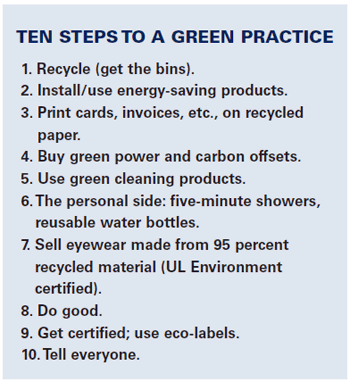 TEN STEPS TO BECOMING
A GREEN PRACTICE
TEN STEPS TO BECOMING
A GREEN PRACTICE
If you agree green is a go, here's a blueprint for your next staff meeting. In fact, once you've agreed on the plan and the dates on which various items are initiated and then regularly implemented, they become merchandisable to your customers. While these are business building for the practice, the real beneficiaries are you and your customers. You may already be doing some of these, but are your customers aware of it? It is necessary then to discuss the communication side of green.
Step 1: Recycle
For many customers, they may assume recycling is standard, but it isn't. For example, I
fly Delta airlines often, and its flight attendants
make a very visible point about separating
the recyclables while picking up trash during
the flight. It takes a little longer but adds to
my satisfaction with them as an airline. Get
the bins that are necessary. It's OK to have
them visible to customers and patients in
the office.
Step 2: Install Energy-Saving Lightbulbs
There are a large variety of CFL and floodlights that are all eco-conscious. They become
a replacement for the regular lights in an
office. For the retail side of the office, conversion to LEDs replicate the specialty and
focused lighting of the places you love to shop.
Step 3: Use Recycled Paper
Be sure to specify that when printing business
cards, practice letterhead, invoices and prescription pads, all materials used should come
from recycled paper. Most printers have this
option. In addition, consider adding "Printed
on recycled paper" for the power that these
words have with the consumer.
Step 4: Buy Green Power
and Carbon Offsets
Bookmark the U.S. Department of Energy's Web page (www.eere.energy.gov) and visit it
to find your local green power energy provider. The U.S. Department of Energy has
programs and partnerships supporting energy
efficiency and renewable energy efforts in
the states and their communities.
For carbon offsets, as little as $100 a year can help fund clean energy projects around the world that offset the environmental impact of other businesses. Contact Native Energy (www.nativeeneregy.com) or e-Bluehorizons (www.bluehorizons.com) for more information and ways to participate.
 Step 5: Use Green Cleaning Products
Step 5: Use Green Cleaning Products
Look at the cleaning products used in your
office and change them to greener products.
In addition, non-perfumed and green cleaners
may be important to patients with allergies. It
says, "I'm thinking of you."
Step 6: Take a Five-Minute Shower,
Reuse Water Bottles
Each of us can do our part every time the tap is
turned on. If you've had a drought in your area,
you've felt the effects of not enough water in the
inability to water lawns or water crops for grazing animals with resulting higher food prices. In
fact, there is not enough clean water worldwide.
Taking a shorter shower and turning off the tap
while brushing or shaving saves water.
For everyday use, it's a good idea to refill that water bottle. Did you know that the U.S. disposes of almost 29 billion water bottles a year that used 17 million barrels of crude to create? Why not reuse a qualified reusable water bottle (BPA-free, washed regularly). Consider using the bottle provided by Eco eyewear, and show it to customers as part of your office program.
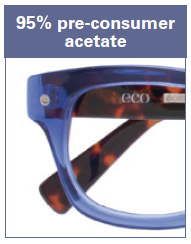 Step 7: Sell 95 Percent
Recycled Material Eyewear
Step 7: Sell 95 Percent
Recycled Material Eyewear
There are only a few companies that make
eyewear from recycled materials and also
provide a complete marketing program for
the practice. Eco eyewear is unique because
the plastic and metal frames are made from
95 percent recycled materials. In fact, its tagline "Born Recycled" is provocative, easily
makes the connection for patients and helps
you start the conversation on why your practice is different by carrying the Eco brand.
For metal frames, the stainless steel components are constructed of 95 percent postconsumer stainless steel, i.e., stainless steel in
products that have been discarded by consumers recycled by a reclaiming and manufacturing process into new eyewear frames.
For acetate frames, they are made from the
reclaimed scrap from the initial acetate
frame manufacturing process.
Why Eco? Eco was developed to be the first eyewear brand committed to sustainability and social responsibility. Designed by the trend-conscious eyewear manufacturer Modo, it combines the style and emotion that consumers demand of eyewear in the only eyewear brand made from 95 percent recycled materials.
The ability to combine style with emotion is the essence of an eyeglass frame that a consumer loves to wear. It helps define their identity. It makes a wearer look good and when made well, it feels good. When it also represents a good idea like sustainability, then it also does good. This has become the positioning of the Eco frame line and is one that works well with consumers—look good, feel good and do good.
Continue to use this positioning by also letting the customer know that this product is the only environmentally-friendly product certified by UL Environment, an independent agency that certifies environmental claims. This approval is given to products that minimize the use of new resources in their production. This validation certifies that Eco eyewear is made of at least 95 percent recycled stainless steel and plastic.
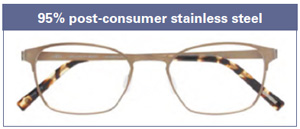
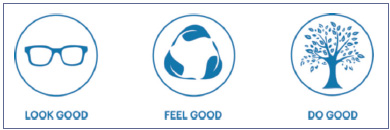
The foldable Eco case is made from recycled PET (polyethylene bottles, not biodegradable) to reduce impact on landfills. All the paper products are made from recycled paper and the envelope in which glasses are received can be reused by consumers to mail their old eyewear to charity organizations. Eco helps donate unwanted eyewear to selected charities that can help provide the gift of sight to the 314 million adults and children worldwide who suffer from poor vision and cannot afford glasses.
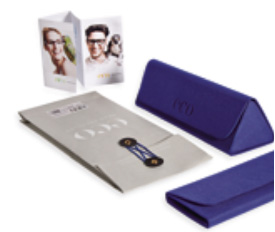 By communicating this,
staff and patients can look
good and feel good about
the way the product has
been created, from what
has been used, how its
been manufactured and into
which products they have been
made.
By communicating this,
staff and patients can look
good and feel good about
the way the product has
been created, from what
has been used, how its
been manufactured and into
which products they have been
made.
Step 8: Do Good, Plant a Tree
Renewal of the
air we breathe
benefits from
every tree that exists and for those that are
planted. Consider a "do good" project like an
office program that supports tree planting.
 To date, 680,000 trees have been planted in
Cameroon on behalf of Modo. In a partnership with Trees for the Future (www.treesforthefuture.com), Eco established the one
frame one tree program and plants a tree for
every frame sold. Trees for the Future, a leading nonprofit "integrates tree planting into
agriculture and land restoration projects."
According to TFT, "Trees bring life back to
degraded lands, create better conditions to
grow food and provide people with a means
to generate income and mitigate climate
change through sequestering carbon dioxide."
To date, 680,000 trees have been planted in
Cameroon on behalf of Modo. In a partnership with Trees for the Future (www.treesforthefuture.com), Eco established the one
frame one tree program and plants a tree for
every frame sold. Trees for the Future, a leading nonprofit "integrates tree planting into
agriculture and land restoration projects."
According to TFT, "Trees bring life back to
degraded lands, create better conditions to
grow food and provide people with a means
to generate income and mitigate climate
change through sequestering carbon dioxide."
Mr. Moshimbo Joseph Nde of Mankon, head of TFT Programs, describes the results of the Modo program for one farmer in Cameroon. He says that training local farmers to use agroforestry techniques by Trees for the Future increases the quality and quantity of crops. That allows the local faring population to support themselves as well as provide additional food for the local markets.

Doing good is also more than ensuring sustainability; it's the ability to extend your reach into the world's communities around you. The consumer is looking to support companies that also improve their environment.
 Step 9: Get Certified, Display an Eco-Label
Step 9: Get Certified, Display an Eco-Label
Consumers look
for sustainable
products so get
certified; then identify your office by displaying an eco-label from a certifying agency.
Consider the Green Business Bureau.
GBB provides independent third-party certification, assessment and tracking software, overall guidance, on-site support and audits to verify certifica- tion as well as tools to grab your customer's attention. Labeling your practice as green lets your customers know your commitment to sustainability. Available are scripts, images, social media messaging and press releases for an ongoing and interactive arsenal of material to let customers know your green commitment. By using eco-conscious third-party labeling, your customers understand your practice participation in sustainability.
Step 10: Tell Everyone
Marketing is the strategy of communicating
with your patients for all the times they are
both in and out of your office, and the time
between visits. Marketing can be done instore or use the variety of social media tools
at our disposal today. Direct marketing might
be a brochure mailed to patient's homes or
handed them when they arrive at reception. It
describes products or services and highlights
their benefits. To communicate a socially
responsible office, consider using all the
vendor available items that use and portray
a consistent theme and positioning.
In-store marketing includes posters and point-of-purchase (POP) materials like countercards and displays. In an innovative move that is easily identified as recycled, Eco display trees are branded "Born Recycled" and are made of a thick, matte gray cardboard. The same is true of the brand plaque. In this way, there is continuity of the message of your office's commitment to the environment and opens the door to say, "This eyewear is made from 95 percent recycled material. It's our commitment to sustainability." Everything is made out of recycled material and ships flat to further decrease the carbon footprint.
IN-STORE MARKETING
Sustainability stories, especially perhaps from a new source like your optical office, are of higher interest. Use them in Facebook posts, as Tweets or for local PR radio, newspaper articles and cable programming. Short articles in text (borrow from this CE course with permission), photos and a short video with audio recorded can get traction at the local stations. Describe the changes to your office programs and the products that are being carried that meet this new social responsibility.
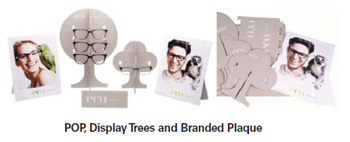
Community involvement and green practices enhance public image. According to a report by DS Simon Productions, "Media initiatives with a corporate social responsibility focus generates 35 to 50 percent more positive media coverage on television, radio, Web and social media than comparable programs." That means public relations items that your office supplies to local radio and cable stations will have a better chance of being picked up for publication. This ensures that more than just your own patients know your office's commitment.
CONCLUSION
Becoming a greener practice is the transitioning from "nice to have" to "must-have". It's an opportunity since there is an unmet demand for sustainable products, and more than eight of every 10 in the U.S. population can be classified as an eco-conscious consumer seeking products and businesses committed to sustainability.
Enhancing your brand with socially responsible products like Eco eyewear, made from 95 percent recycled materials, benefit the customer, the community and adds to patient loyalty and preference. It creates an environ- ment that makes all in the office proud of where they work. Become a green practice and see your business bloom.
